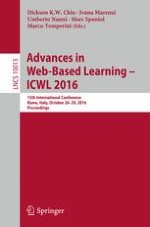2016 | OriginalPaper | Buchkapitel
Understandable Prediction Models of Student Performance Using an Attribute Dictionary
verfasst von : Shaymaa E. Sorour, Shaimaa Abd El Rahman, Samir A. Kahouf, Tsunenori Mine
Erschienen in: Advances in Web-Based Learning – ICWL 2016
Aktivieren Sie unsere intelligente Suche, um passende Fachinhalte oder Patente zu finden.
Wählen Sie Textabschnitte aus um mit Künstlicher Intelligenz passenden Patente zu finden. powered by
Markieren Sie Textabschnitte, um KI-gestützt weitere passende Inhalte zu finden. powered by
